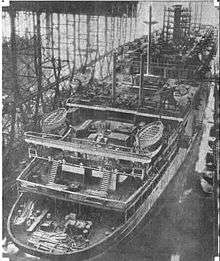SS Washington
 SS Washington With The United States Lines Livery Colors. | |
| History | |
|---|---|
| Ordered: | 24 May 1930 |
| Builder: | New York Shipbuilding Corp., Camden |
| Laid down: | 20 January 1931 |
| Launched: | 20 August 1932 |
| Commissioned: | 16 June 1931 |
| Decommissioned: | 18 January 1946 |
| In service: | 1934-1940, 1947-1957 |
| Out of service: | 1957 |
| Refit: | 1947, 1955 |
| Struck: | 1962 |
| Homeport: | New York, New York |
| Nickname(s): | "President Washington's Ship" |
| Fate: | scrapped 1965 (Kearny, NJ) |
| Status: | scrapped |
| Notes: | Flagship from 1934-1940 |
| General characteristics | |
| Class and type: | America Class |
| Tonnage: | 24,289 GRT |
| Length: | 705 ft 3 in (214.96 m) |
| Beam: | 86 ft 0 in (26.21 m) |
| Decks: | 8 |
| Propulsion: | B&W boilers, Parsons steam turbines (30,000 shaft HP) - twin screw |
| Speed: | 20.5 knots |
| Crew: | 565 |
| Armament: | (as Mount Vernon) four 5" guns, four 3" guns |
SS Washington was a 24,189-ton luxury liner of the United States Lines, named after the US capital city.
Construction

Washington was ordered by Transatlantic Steamship Company and laid down on 20 January 1931 in Shipway O at New York Shipbuilding in Camden, New Jersey. By the time the vessel was launched on 20 August 1932, Transatlantic Steamship's assets had been acquired by International Mercantile Marine, and the Washington went into service for the United States Lines following delivery on 2 May 1933.
At the time of their construction, Washington and her sister ship SS Manhattan, also built by New York Shipbuilding, were the largest liners ever built in the United States, a status they held until the 1939 launch of SS America. Washington and Manhattan were two of the few pure ocean liners built by New York Shipbuilding, which had previously built a large number of cargo liners. Accommodations were 580 in Cabin class, 400 in Tourist, and 150 Third class. Both ships were to garner a reputation for a very high standard of service and luxury.
United States Lines signed contracts in 1931 for the Manhattan and Washington for approximately $21 million each.[1] This was a substantial cost in a depression era and considered a gamble by men in the passenger liner business. The Haskelite Manufacturing Corporation provided various types of haskelite plywood for the two ships.[2]
Commercial career

Washington joined her sister ship Manhattan on the New York-Hamburg route, a route she continued to serve with only one short break until December 1939, when Roosevelt invoked the 1939 Neutrality Act against Germany. Both ships then moved to the New York-Naples-Genoa run until Italy declared war on Great Britain and France in June 1940. With the increasing danger from German submarines, Washington and Manhattan were shifted to the New York-San Francisco service via the Panama Canal.
Military career
On 6 June 1941, Washington was requisitioned and leased by the US Navy, and was subsequently commissioned as the troopship USS Mount Vernon on 16 June 1941. The conversion was performed by the Philadelphia Navy Yard. In Navy service, Mount Vernon frequently sailed in company with the other United States Lines fast liners Manhattan (USS Wakefield) and America (USS West Point), most notably on a secret assignment carrying British troops to Singapore—a convoy mission which began a month before Pearl Harbor.
In January 1946, Mount Vernon was decommissioned and returned to the U.S. Maritime Commission, regaining the name Washington at that time. Her luxurious appointments had been carefully removed and stored, and she returned to commercial service in February 1947. Only one deck was restored to its pre-war standards, however, and the ship now provided accommodations for 1106 passengers in a single class. United States Lines returned her to the U.S. government in October 1951, and the final phase of her career found her transporting soldiers and their families between New York and Bremerhaven. Laid up in reserve in the Hudson River in 1953, she was ultimately scrapped at Kearny, New Jersey in 1965.
References
- ↑ "Uncle Sam Enters The Atlantic Race", February 1931, Popular Mechanics article on the new construction in the 1930s
- ↑ Marine_Engineering 1933, p. 208.
Sources
- Gibbs, C.R. Vernon (1957). Passenger Liners of the Western Ocean (2nd ed). London: Staples Press Limited. LCCN 57001880
- Marine_Engineering (1933). Marine Engineering. Simmons-Boardman Publishing Corporation.
- New York Shipbuilding Corporation (1948). 50 Years: New York Shipbuilding Corporation. Camden:house publication
- Newell, Gordon (1963). Ocean Liners of the 20th Century (1st ed.). Seattle: Superior Publishing Company. LCCN 63-18494